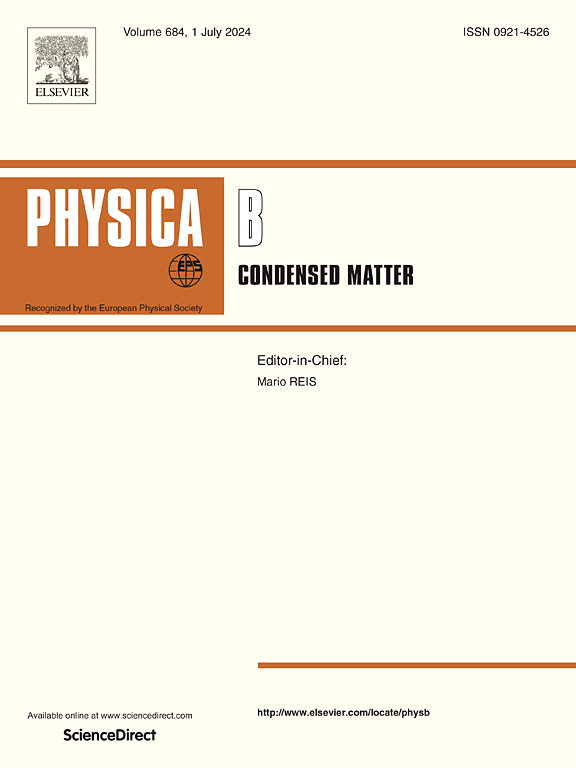角度和键距变化对钙钛矿输运性质的影响
IF 2.8
3区 物理与天体物理
Q2 PHYSICS, CONDENSED MATTER
引用次数: 0
摘要
讨论了电导率响应、直接和间接阳离子相互作用、阳离子-阴离子键距离和阳离子-阴离子-阳离子角之间的关系。结果表明,阳离子-阳离子和阳离子-阴离子-阳离子相互作用本质上控制着各种氧化物中载流子的动力学。含过渡金属阳离子材料的电输运性质与阳离子-阳离子/阳离子-阴离子键距和阳离子-阴离子-阳离子(α)角值直接相关。因此,对于α >;135°,对于弱阳离子-阴离子长度,观察到强阳离子-阴离子-阳离子相互作用,从而暗示半导体行为的出现。明显地,当阳离子-阴离子-阳离子角升高(α约180°)时,没有看到阳离子-阳离子相互作用,这支持了具有半导体行为的材料的发展。在这项工作中,电导率的温度依赖性被认为是估计Mn- Mn与Mn- o -Mn相互作用的相对幅度。因此,对于具有强Mn - Mn相互作用的锰酸盐,可以在低温下形成共价键。上述材料族中金属行为的出现与Mn - Mn相互作用程度的提高有关。对于各种氧化物体系,共价型阳离子-阳离子键的形成改善了从金属到半导体的相变行为,可以是合作的,也可以是不合作的。在一定的温度值下观察到合作转变。然而,在有限的温度域内,非合作转变是明显的。本文章由计算机程序翻译,如有差异,请以英文原文为准。
Impact of angle and bond distance variation on the transport properties of perovskites
Relations between the electrical conductivity responses, the direct and indirect cation interactions, the Cation-Anion bond distances, and the Cation-Anion-Cation angles are discussed. It is shown that both Cation-Cation and Cation-Anion-Cation interactions govern essentially the dynamics of the charge carriers in various oxide compounds. The electrical transport properties for materials containing transition metal cations are directly related to the Cation-Cation/Cation-Anion bond distances and Cation-Anion-Cation (α) angle values. Accordingly, for α > 135° and for weak Cation-Anion length, strong Cation-Anion-Cation interactions are observed, thus implying the appearance of a semiconductor behavior. Explicitly, for elevated Cation-Anion-Cation angle (α around 180°), no Cation-Cation interaction can be seen, which supports the development of materials with a semiconductor behavior. In this work, the temperature dependence of the electrical conductivity is considered to estimate the relative magnitudes of the Mn - Mn versus Mn-O-Mn interactions. Accordingly, for manganites with strong Mn - Mn interactions, covalent-type bonds may be formed at low temperatures. The appearance of metallic behavior within the mentioned material family is linked to the improvement of the Mn - Mn interactions degree. For various oxide systems, covalent-type Cation-Cation bond formation improves the phase transition from the metallic to the semiconductor behaviors, which can be cooperative or non-cooperative. The cooperative transition is observed at a definite temperature value. While, the non-cooperative transition can be noticeable over a finite temperature domain.
求助全文
通过发布文献求助,成功后即可免费获取论文全文。
去求助
来源期刊

Physica B-condensed Matter
物理-物理:凝聚态物理
CiteScore
4.90
自引率
7.10%
发文量
703
审稿时长
44 days
期刊介绍:
Physica B: Condensed Matter comprises all condensed matter and material physics that involve theoretical, computational and experimental work.
Papers should contain further developments and a proper discussion on the physics of experimental or theoretical results in one of the following areas:
-Magnetism
-Materials physics
-Nanostructures and nanomaterials
-Optics and optical materials
-Quantum materials
-Semiconductors
-Strongly correlated systems
-Superconductivity
-Surfaces and interfaces
 求助内容:
求助内容: 应助结果提醒方式:
应助结果提醒方式:


